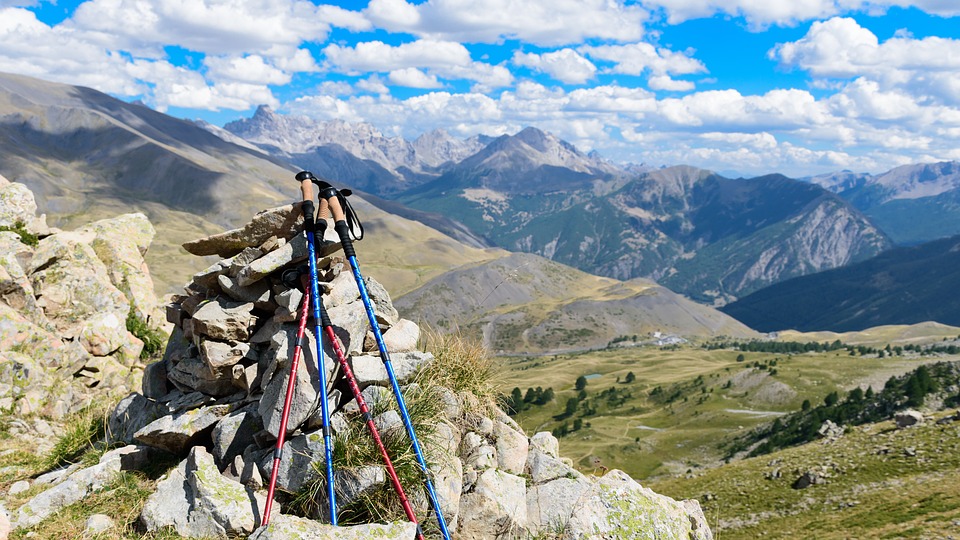Hiking Boots, Shoes or Trail Runners?
Footwear choice for mountain hiking is, honestly, one of the most important decisions I think you can make. Blisters, wet feet, lacking support, lacking comfort… all of those things can have a profoundly negative impact on your hiking enjoyment.
Whilst heavier traditional hiking boots were once seemingly the default choice for hikers, modern hiking footwear has seen a real shift towards lighter, more agile alternatives.
A trail runner is essentially a running shoe that’s been beefed up with better support and traction/grip, specifically designed to handle the uneven ground you’ll experience when hiking or running off road, in the hills or even mountains as opposed to than just stomping pavements. They’re made for light, springy movement – nimble and quick!
Hiking shoes, on the other hand, sit comfortably in the middle ground between trail runners and those traditional hiking boots. Whilst they might look quite similar to trail runners, they’re built with more structural support and tougher, longer lasting soles. They’re designed to be robust, durable, and offer a fantastic blend of agility, stability and versatility across all sorts of terrains.
And then you have hiking boots, the classic choice, built for maximum protection, unwavering stability, and incredible durability. They often feature a higher cut to really support your ankle and a more rigid construction, perfect for tackling challenging terrain and carrying heavy loads.
It’s worth pointing out though that even higher sitting hiking boots these days tend to be much lighter than more traditional leather boots. I wear Inov-8 Roclite Pro G 400 goretex boots and they were fine out of the box and really are comfortable and light.
Now, I’ve popped together a summary of features below but do bear in mind this is just a loose idea. In reality the specifics can vary hugely from model to model.
| Feature | Trail Runners | Hiking Shoes | Hiking Boots |
|---|---|---|---|
| Weight | 550 to 650g per pair | 650 to 750g per pair | Typically 750g+ and winter boots in particular can be much heavier |
| Ankle Support | Limited to none | Limited to none given the low cut design | High in mid to high hiking boots provided they’re laced correctly |
| Foot Protection | Minimal | Good | Maximum |
| Durability | Lower – expect about 500 miles out of a pair before you need to replace them | Higher – expect about 800 miles | Very high – should be expecting over 1,000 miles in my opinion |
| Breathability | High (mesh uppers, quick-drying) | Moderate (sacrifices some for durability, generally more breathable than boots) | Lower (can be hot and lead to sweaty feet, particularly with heavier winter boots |
| Sole Stiffness | Flexible | Stiffer – more structural support) | Rigid/Stiffer in many cases, particularly with winter boots |
| Break in Time | None – usually fine out of the box | Minimal – generally comfortable out of box | Varies – some are fine out of the box (particularly 3 season modern boots). Some can take 50 miles or so to walk in |
| Ideal Bag Weight | Light loads up to 11kg or so | Light to Medium loads – 10 to 15kg | Heavy loads over 15kg |
Trail Runners: Lightweight Agility for Fast and Light Mountain Days
What Are Trail Runners?
Trail runners are essentially high performance running shoes adapted for off road use. Lightweight, breathable, and designed for agility, they’re a really solid choice for hikers who favour speed and responsiveness over traditional support. Think of them as the minimalist’s answer to mountain footwear perfect for fast-and-light missions or seasoned hikers who prefer a more natural stride.
Compared to road running shoes, trail runners typically have:
Grippier soles with multi-directional lugs
More durable uppers, often made of mesh for more breathability
Reinforced toe caps for rocky terrain
Stiffer midsoles for better responsiveness
Models like the Altra Lone Peak 8 blur the line between trail running and lightweight hiking, while the Brooks Cascadia 18 leans more towards dedicated trail running. So the specific model you choose will most likely depend on what you plan to do in them.
The Philosophy – Speed and Efficiency Over Protection
The ethos behind trail runners is simple – reduce energy expenditure per step and increase agility. For long distance hiking days, where every last gram counts, cutting footwear weight makes a real difference. Less weight on your feet means less fatigue, more miles and faster progress.
But this efficiency comes with a price – mostly in the form of reduced protection and support. They’re ideal for fit, experienced hikers carrying light bags but probably less practically if you’re hauling 15kg+ over tough, uneven ground – the type of which we always encounter when hiking mountains.
Hiking Shoes: A Balance of Protection and Agility
What Are Hiking Shoes?
Hiking shoes sit bang in the middle between trail runners and traditional boots. They offer more structure, protection and durability than trail runners but without the added bulk of boots. Their stiffer soles and robust uppers make them an excellent choice for varied terrain and days where you’re carrying a medium weight bag.
They typically feature:
Reinforced toe boxes and sides
More rigid soles for stability on uneven ground
Aggressive lug patterns for grip on mixed terrain
Durable fabrics or leather uppers, sometimes with waterproofing too
Why Choose Hiking Shoes?
Hiking shoes are all about balance. They deliver enough protection for rocky paths and steep descents, while remaining light enough to keep you moving efficiently. They’re a pretty solid choice for most mountain conditions, especially when carrying 9–15kg of extra weight on your back.
The main advantages of hiking shoes include:
Better load support: Compared to trail runners, they offer more support for those carrying medium weight back in the sort of 10kg to 15kg weight range
All round grip: Their aggressive tread patterns work across mud, rock, and scree.
Improved durability: Built to last longer, hiking shoes are a sound investment for regular walkers.
That said, they’re not as breathable or quick drying as trail runners, and the added weight may slow you down slightly on days where you’re planning to cover a lot of distance
Hiking Boots: Maximum Support for Rugged Terrain and Heavy Loads
What Are Hiking Boots?
Hiking boots are the go-to choice for challenging mountain conditions and longer distance or even multi day hikes. With high cut ankles, stiffer midsoles and generally waterproof materials, they offer the highest level of support and protection.
Typical features include:
Tall ankle collars for stability and protection
Stiff midsoles for heavy load support
Deep, aggressive lugs for grip in mud, scree, or snow
Waterproofing and insulation for cold or wet weather
When Are Boots the Best Option?
Boots excel when the going gets tough. If you’re tackling steep, unstable terrain, crossing snowfields, or carrying 16kg+, they provide the foundation you need.
Benefits include:
Superior ankle support: Reduces risk of twists on rugged trails.
Maximum protection: Shields against rocks, debris, and rough ground.
Warmth and weather resistance: Ideal for cold, wet, or high altitude environments.
Exceptional longevity: Quality boots can last for years with proper care.
The trade offs? They’re heavier, take longer to dry, and usually require a break-in period. Agility suffers too, especially on nimble terrain where precise footwork is needed.
Which Hiking Footwear is Right for You?
The best footwear depends on three key factors: terrain, bag weight and personal preferences.
Consider Your Terrain
Smooth or maintained trails? Trail runners are usually fine.
Mixed mountain paths with roots and rocks? Hiking shoes offer the best balance.
Off-trail, steep, or snowy routes? Hiking boots provide essential support and protection.
Match Footwear to Your Bag Weight
<11kg: Trail runners or hiking shoes.
9–15kg: Hiking shoes are ideal.
16kg+: Opt for hiking boots.
Factor in Weather and Your Experience Level
Warm and dry: Trail runners shine.
Cold and wet: Go for waterproof hiking shoes or boots.
Beginner or weak ankles? Stick with boots or hiking shoes for better support.
Experienced and well-conditioned? Trail runners may suit your fast-paced style.
Personal Preference and Mix and Match
So much of your footwear choice when hiking (particularly mountains which can be long, strenuous days) is down to personal preference.
Sometimes it will seem like every man and his dog has an opinion on what’s on your feet when you hike. And yes, of course, it would be a little bit daft to head up the hills in a pair of Crocs or trainers made for tennis rather than terrain! But when it comes to choosing between trail runners, hiking shoes and hiking boots, all have their pros and cons.
So decide what’s right for you.
Personally, for mountain days, I tend to wear lightweight and waterproof hiking boots. I’ve ended up with wet feet in trail runners too many times (I’m still mad at you, bogs). So I like Goretex boots.
But if I’m out on a trail like the Derwent Water circular where much of it is well pathed and you’re not generally navigating bogs, I would be equally happy to do that in trail runners or lightweight hiking shoes/trainers – big fan of the North Face Vectiv Futurelights here).
So do some hiking and work out what you prefer!






